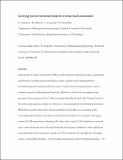Surveying the Environmental Footprint of Urban Food Consumption
Author(s)
Goldstein, Benjamin; Birkved, Morten; Fernandez, John; Hauschild, Michael
DownloadAccepted version (606.0Kb)
Alternative title
The Urban Foodprint
Terms of use
Metadata
Show full item recordAbstract
Assessments of urban metabolism (UM) are well situated to identify the scale, components, and direction of urban and energy flows in cities and have been instrumental in benchmarking and monitoring the key levers of urban environmental pressure, such as transport, space conditioning, and electricity. Hitherto, urban food consumption has garnered scant attention both in UM accounting (typically lumped with “biomass”) and on the urban policy agenda, despite its relevance to local and global environmental pressures. With future growth expected in urban population and wealth, an accounting of the environmental footprint from urban food demand (“foodprint”) is necessary. This article reviews 43 UM assessments including 100 cities, and a total of 132 foodprints in terms of mass, carbon footprint, and ecological footprint and situates it relative to other significant environmental drivers (transport, energy, and so on) The foodprint was typically the third largest source of mass flows (average is 0.8 tonnes per capita per annum) and carbon footprint (average is 2.1 tonnes carbon dioxide equivalents per capita per annum) in the reviewed cities, whereas it was generally the largest driver of urban ecological footprints (average is 1.2 global hectares per capita per annum), with large deviations based on wealth, culture, and urban form. Meat and dairy are the primary drivers of both global warming and ecological footprint impacts, with little relationship between their consumption and city wealth. The foodprint is primarily linear in form, producing significant organic exhaust from the urban system that has a strong, positive correlation to wealth. Though much of the foodprint is embodied within imported foodstuffs, cities can still implement design and policy interventions, such as improved nutrient recycling and food waste avoidance, to redress the foodprint. Keywords: agriculture; cities; food consumption; foodprint; industrial ecology; urban metabolism
Date issued
2016-01-07Department
Massachusetts Institute of Technology. Department of ArchitecturePublisher
Wiley
Citation
Goldstein, Benjamin et al. "Surveying the Environmental Footprint of Urban Food Consumption." Journal of Industrial Ecology 21, 1 (February 2017): 151-165 © 2016 Yale University
Version: Author's final manuscript
ISSN
1088-1980